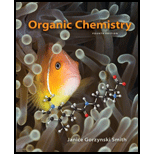
(a)
Interpretation: The alkyl halide which forms the given alkene as the only product in an elimination reaction is to be stated.
Concept introduction:
(b)
Interpretation: The alkyl halide which forms the given alkene as the only product in an elimination reaction is to be stated.
Concept introduction: Alkyl halides undergo elimination reaction in the presence of a base to form alkenes. The mechanism of the reaction depends on the base used. The most substituted alkene is formed as the major product according to Zaitsev rule.
(c)
Interpretation: The alkyl halide which forms the given alkene as the only product in an elimination reaction is to be stated.
Concept introduction: Alkyl halides undergo elimination reaction in the presence of a base to form alkenes. The mechanism followed depends on the base used. The most substituted alkene is formed as the major product according to Zaitsev rule.
(d)
Interpretation: The alkyl halide which forms the given alkene as the only product in an elimination reaction is to be stated.
Concept introduction: Alkyl halides undergo elimination reaction in the presence of a base to form alkenes. The mechanism followed depends on the base used. The most substituted alkene is formed as the major product according to Zaitsev rule.
(e)
Interpretation: The alkyl halide which forms the given alkene as the only product in an elimination reaction is to be stated.
Concept introduction: Alkyl halides undergo elimination reaction in the presence of a base to form alkenes. The mechanism followed depends on the base used. The most substituted alkene is formed as the major product according to Zaitsev rule.
Want to see the full answer?
Check out a sample textbook solution
Chapter 8 Solutions
Organic Chemistry-Package(Custom)
- The reaction Q(g) + R(g) → Z(l) is shown to be exothermic. Which of the following is true concerning the reaction. it is spontaneous only at High T, it is spontaneous at low T it is nonspontaneous at all T it is spontanrous at all T. it is non spontaneous only at low T.arrow_forwardThe reaction Q(g) + R(g) → Z(l) is shown to be exothermic. Which of the following is true concerning the reactionarrow_forwardWhich of the following has the largest standard molar entropy, S° (298.15 K) He H2 NaCl KBr Hgarrow_forward
- Which of the following is true for a particular reaction if ∆G° is -40.0 kJ/mol at 290 K and –20.0 kJ/mol at 390 K?arrow_forwardWhat is the major product of the following reaction? O O OH OH 1. BH 2. H₂O₂, NaOH OH OHarrow_forwardDraw the products formed when each ester is hydrolyzed with water and sulfuric acid.arrow_forward
 Organic ChemistryChemistryISBN:9781305580350Author:William H. Brown, Brent L. Iverson, Eric Anslyn, Christopher S. FootePublisher:Cengage Learning
Organic ChemistryChemistryISBN:9781305580350Author:William H. Brown, Brent L. Iverson, Eric Anslyn, Christopher S. FootePublisher:Cengage Learning Organic Chemistry: A Guided InquiryChemistryISBN:9780618974122Author:Andrei StraumanisPublisher:Cengage Learning
Organic Chemistry: A Guided InquiryChemistryISBN:9780618974122Author:Andrei StraumanisPublisher:Cengage Learning Chemistry for Today: General, Organic, and Bioche...ChemistryISBN:9781305960060Author:Spencer L. Seager, Michael R. Slabaugh, Maren S. HansenPublisher:Cengage Learning
Chemistry for Today: General, Organic, and Bioche...ChemistryISBN:9781305960060Author:Spencer L. Seager, Michael R. Slabaugh, Maren S. HansenPublisher:Cengage Learning- Chemistry: Matter and ChangeChemistryISBN:9780078746376Author:Dinah Zike, Laurel Dingrando, Nicholas Hainen, Cheryl WistromPublisher:Glencoe/McGraw-Hill School Pub Co



